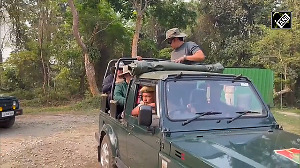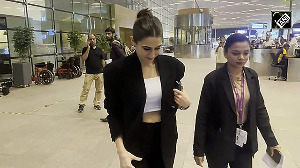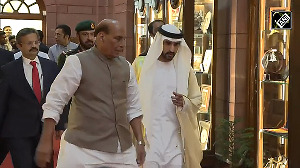Five years ago, a 6.9 Richter earthquake devastated Gujarat, and especially Kutch, in the northwestern region of the state, on Republic Day.
Hours after the heart-wrenching images of the disaster made headlines across the world, relief and donations swamped Gujarat. The government and NGOs immediately swung into action.
A Gujarat-based NGO, Kutch Nav Nirman Abhiyan, led by Sushma Iyengar, spearheaded the relief work done by some 40 organisations in this region. Iyengar has spent the last five years working tirelessly, and with super-efficiency, on the reconstruction of Kutch. She is one of the individuals responsible for the new trends set in Kutch in areas like disaster management, rehabilitation of victims of a natural disaster and the reconstruction of destroyed villages.
Armed with a degree in development communication from Cornell University, US, Iyengar started doing social work in Gujarat in the 1980s with the Kutch Mahila Vikas Sanghthan. Currently she is focused on a project to set up a communication network in the form of information kiosks to help communities. She is also working in drought proofing and environmental issues.
Sushma Iyengar spoke to Managing Editor Sheela Bhatt on the reconstruction of Kutch.
How has Kutch changed in the last five years? What has the post-earthquake management been like?
A lot of things have evolved. Some drastically. Some gradually. The most obvious evolution has been the speed with which a new Kutch has been rebuilt in towns and villages.
The Gujarat earthquake coverage
You need to look at Kutch in relative terms and compare it to other disasters and work done there. By and large, town planning was not compromised. In rural areas communities have remained in the centre of efforts when it came to reconstruction of their homes. There has been involvement of the community and they have provided the structure within which authorities could function. Kutch has certainly set the precedent for rehabilitation.
What made this possible?
I think many people don't give credit to the policy framework provided by government within which non-governmental organisations functioned.
Secondly, the spirit of Kutchis. Disasters have happened elsewhere also but here support of all type was synergised. In Kutch the rural folk realized faster than the urban folk that there was an opportunity for them in the revival efforts.
Thirdly, so many organisations reached out to help Kutch.
All three have been critical factors in the rebuilding of Kutch.
What are the lessons learnt during the reconstruction of Kutch?
There have been a lot of lessons. Let us look, for instance, at housing. Seventy-six per cent of the new homes were built by the owners themselves. That's the first lesson which has to be studied in depth. People's efforts were financially supported by the government. They were also given technical support by the government by way of engineers.
The government also gave them material at cheaper rates. With these three critical areas of support they rebuilt their homes. And I am not even talking about NGO-supported reconstruction.
Wherever the rebuilding of homes was driven by the owners, it was accomplished with speed. The government and NGOs need to learn from this.
See what is happening in Tamil Nadu after tsunami. So much money came in from NGOs and international aid agencies. The government has moved back. Only 130 villages are in the worst-affected category. It should not have taken more than a year to build new homes. But the government is not putting money in, so reconstruction has hardly begun.
The reconstruction process in Tamil Nadu lacks speed because the state has not put a framework into place and NGOs are asking contractors to build homes there. In Kutch people themselves were given money. When you construct your own home you will put your heart into it. You will ensure quality and speed. Absence of contractors was a major factor in the rebuilding of Kutch with speed.
But I think the lessons of Kutch have not been absorbed properly. The same agencies who worked in Kutch are not applying the same policies they leart in Kutch in Kashmir and Tamil Nadu. That is: after a disaster, don't start designing homes for somebody. Let the victim participate and have his say. NGOs should be a facilitator.
I think the governments of other Indian states should take heed of this lesson learnt. After a disaster if you don't manage the people NGOs who come in then you create a bigger disaster. Communities are confused when there are multiple agendas. Each NGO comes with its own agenda -- each one is an actor and there is no director.
Like we did in Kutch, we have created the Nagapattanam Co-ordination Resource Centre [Iyengar's organisation held discussions with local groups in Tamil Nadu in 2005 to help with the post-tsunami reconstruction process. They were also invited to Kashmir and Indonesia]. It's not across Tamil Nadu. It is in one district only. The NGOs are running it with the government as partner. The two together are creating policies. In the same manner in Kashmir we are creating a system where synergy can take place.
What are your complaints about the Kutch reconstruction process?
Kutch's villages don't look the way they did before the earthquake. At places where local folk have brought in originality, it is still visible but where outsiders have built villages it lacks in spirit. It looks colourless and without the Kutchi warmth.
If my daughter is dead let me look for my wife
Kutchi spirit, cattle, craft, architecture, aesthetics and homes all combined in a very unique way before the earthquake to give a look to the culture. It harmonised effortlessly. But now those villages developed on main roads lack aesthetics.
NGOs and many donors wanted to have their hoarding signs on the roads. So the villages they developed were along the road, where their work would be more visible. I am not saying urban people have the right to develop as they like and rural areas should not change and must maintain traditions. I am saying we can harmonise livelihood, habitats and housing. Governments and NGOs should learn how to maintain that.
Were you successful in achieving that?
Not all members of our organization could. But we took care that relocation was not forced on villages. Wherever possible reconstruction was done on the same site. We have helped them upgrade. The one thing that is nice about the villages there today is that I can see less difference between rich and poor areas.
Across India, housing is a status symbol. One can always say where a Dalit lives and where upper caste folks live. Now that distinction has reduced in many places in Kutch. Rich people have upgraded their homes but by and large all of them have got similar homes. More people are now better off than before.
The towns are also better off than before. But I think we should have retained the old Bhuj as a heritage city. I think that opportunity has been lost. Bhuj had a fort which could have been saved. All the areas of Bhuj now look similar. The culture of lanes and bylanes and the cosy feeling of living in clusters is no longer seen. Somewhere that part could have been preserved.
What about the corruption that dogged reconstruction efforts? Why did that happen?
The corruption started with debris removal in rural areas. A lot occurred during certification process by engineers and during bank transfer of government subsidies. The reconstruction was divided in phases. At the completion of every phase government-appointed engineers were supposed to give certification of quality and quantity of construction. Cash payment to victims by the government also depended on certification. If the state government could handle such huge rehabilitation projects very capably, I am sure it could have contained corruption too if it wanted to. Multiple cheques were issued for the rebuilding a house. One interpretation of the fast rebuilding activity in Kutch was that many people got two cheques instead of one at all three stages of reconstruction.
Were Dalits and Muslims excluded in any way from the benefits of the reconstruction process? Was there any discrimination?
Not at all. I am not keen to extol any political parties for any biases which they have, but I don't agree with this charge.
It was very difficult to leave out anybody in view of the kind of support that was coming in. Two hundred NGOs were sitting right here.
Rather, in fact, it was the urban poor who were ignored. There was no tenant policy for many months. People who lived on land that they had encroached upon had no place to go. The new sites had no infrastructure for a long time. The urban poor were left out in the first round of town planning. In Bhuj new people are constantly pouring in. Their problems need to be addressed now.
How Prakash was brought to life
New slums will come up in two years and we need to plan for them now.
Have the reconstruction efforts in Kutch been marred by politics?
In Tamil Nadu people are more aware of their rights than in Kutch. The fishing community in Tamil Nadu has often been demanding two new homes. They are politically organised and have a very strong say with the state. Tamil Nadu politics operates on the demands of such communities. In Kutch the administration was allowed to do its job.
In Tamil Nadu the bureaucracy is excellent but things only move the way Chief Minister J Jayalalithaa wishes. She controls the collectors directly. Because of this there are blockages. Of course, in other respects collectors have more powers in Tamil Nadu than in Gujarat.
Several of your colleagues, who worked with you on the Kutch reconstruction project, have gone to Indonesia for post-tsunami reconstruction. Can you share their experiences?
Leeladhar Gada, Mahavir Acharya, Sandeep Virmani, Mansi Anand and Kiran Vaghela of Hunnar Shaala of the Shelter Division [the crafts department of a Gujarat-based NGO involved in teaching victims affordable and environment-friendly technology to build cheap homes] have been making trips to Indonesia to help with the reconstruction work in Aceh, by patterning it on the Kutch model.
They are offering help with shelter technologies and in bringing about people's participation. They are trying to transform the post-tsunami work there into a people's campaign. That helps reduce trauma too. The Kutchi water resource team has also gone there to help with planning because their water has turned saline.
Kutchis are working in 25 villages there. The local people in Bandeh Aceh have found more understanding emotionally with the Gujarat team, because Islam went to Aceh from Gujarat by the sea route. A Gujarat-based Sufi saint took a more liberal Islam to Aceh. When our team went there they were shown a holy tree and a shrine of a Sufi saint who came to Aceh from Gujarat. They said Islam came to Indonesia from Gujarat!
Many donors to the Gujarat cause feel their money was not used well. Is that true?
Donors should first ask themselves what were they doing when they gave the money. Were they not monitoring it once in four years? They should have asked questions. Got expenses audited. A careful donor should ensure money goes the right way.
Secondly, the whole obsession should not be about money. Some of the donors visit villages they donated to to check their names on hoardings [signs] but not the homes behind a hoarding. People talk of an indifferent government but we have seen some cases where donors can be very insensitive. Some of them were more bothered with the act of giving but not with the end use of money.
What is the fate of the women of Kutch after the earthquake?
They were bold even before the earthquake but didn't venture out. Now they have. Some 200 NGOs that came to Kutch created hulchul [hubbub] among local communities. Totally, 1025 self-help groups have been formed. Some of them are bogus because Kutch has just 960 villages. In fact it became an unfortunate formula that only if the women formed a group would NGOs work with them. Those NGOs didn't have much of an idea of women empowerment.
But on a more positive note, women came out of their homes in these last five years; something which they could not manage in decades. Women are demanding things, demanding issues.
Weavers are finding that their women are not helping them anymore in their trade. It has reduced production. Women don't find value in doing traditional things.
Also, after the earthquake the more nuclear nature of families has resulted in more stress. In last five years in Kutch 1,400 deaths of women have been reported due to suicides or homicides. The figure for unnatural deaths is higher because more families are reporting them. Earthquakes have brought about breakups of families. An absence of family support systems is adding to stress. The people here are not able to handle nuclear family life because they are not used to it.
Did the Kutch reconstruction happen in the manner you dreamed it would?
We had no time to dream then. But I would say on scale of 10 we have achieved eight. The rehabilitation of craftsmen was facilitated by several NGOs as well as by Khamir [Center for Kutch Heritage Arts, Music, Information and Resources]. Shelter technologies have worked. Setu's [an organisation that acts as a bridge between the people, NGOs, the government, donors and experts in a cluster of villages] experiment to set up a small facilitation centre for coordination of villages has worked. Rehabilitation has been good, by and large.
Crores [ten millions of rupees] have been spent to develop cities. But not even two per cent has been spent on empowering and gearing up municipalities and on better governance. There is no sign of professionalism in local governance.
But there have been fallouts. Corruption is an issue. Industrialisation is an offshoot of the earthquake and is the major area of concern. We are still not being able to create a dialogue within our society on how to accommodate industrialisation while retaining traditional livelihoods. One doesn't have to happen at cost of the other. It is debated that industrialization is equal to development. Therefore, by that logic, anything that raises doubt on industrialisation is anti-development. That becomes too simplistic an argument.
But Kutch should debate. We should think of more creative solutions.
Do people still live in fear of earthquake recurring?
Not in constant fear. But now we are more aware of earthquakes. But even now if there is a tremor people come out of their homes. Fear lies buried in their unconscious mind. But I would say we are more cautious of an earthquake now.






 © 2025
© 2025